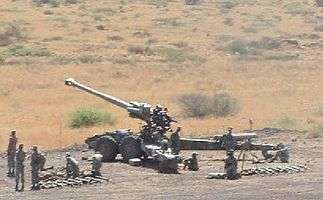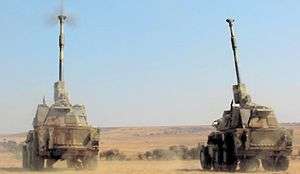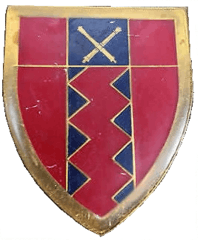South African Army Artillery Formation
| South African Army Artillery Formation | |
|---|---|
|
SANDF Artillery Formation emblem | |
| Active | 1999 to date |
| Country |
|
| Allegiance |
|
| Branch |
 |
| Type | Artillery |
| Part of | South African Army |
| Colors | Guardsmen Red and Oxford Blue[1] |
| Commanders | |
| General Officer Commanding (GOC) | Brig Gen Khaya Makina |
| General of the Gunners | Maj Gen Jabu Mbuli |
| Insignia | |
| Collar Badge | Bursting grenade with seven flames |
| Beret Colour | Oxford Blue |
| Artillery Battery Emblems |
 |
| Artillery Beret Bar circa 1992 |
 |
The South African Army Artillery Formation is the controlling entity of all South African Army artillery units. It draws much of its history from the South African Artillery, established in 1934 but with roots that reach back to 1921. The formation consists of both regular and reserve units. There is a separate South African Army Air Defence Artillery Formation that directs army anti-aircraft warfare units.
History
Origins
The South African Permanent Force, created in 1913 as the Permanent Force and re-designated with effect from 23 February 1923, included the South African Field Artillery (SAFA), and the South African Permanent Garrison Artillery (SAPGA). The SAPGA had begun operations some time before, when the coastal defences of the Cape Peninsula (manned by the Cape Garrison Artillery) had been handed over to South Africa in December 1921.

In Proclamation No. 246 of 1934, the Governor General of the Union of South Africa merged the two organisations with effect from 1 September 1934 and created one Corps titled the South African Artillery (SAA) (see South African Army corps and branches).
World War 2
Nine field regiments, two medium regiments, and three anti-tank regiments served in North Africa and Italy during the Second World War.[2]
1st Medium Regiment SAA (SAHA) was formed briefly from 1 October 1939 - July 1941, when it was broken up in Egypt to provide replacements for the field regiments of the SAA. It was reformed with headquarters at Cape Town from 1 January 1946. It was transferred from Cape Town and out of Cape Command to Oudtshoorn from 31 December 1953, but was then disbanded after a Citizen Force reorganisation on 1 March 1960.[3]
Post World War 2
From 1 July 1951 8 Field Regiment SAA was active, but was redesignated the Johannesburg Regiment in 1960.
Bush War period
10 Artillery Brigade South Africa, was active with 4 and 14 Regiments since 1983, and 14 Artillery Regiment disbanded on January 1, 1993.
National Defence Force Reorganisation
The army's reorganisation after the creation of the new South African National Defence Force was lengthy. The SA Army Office was established. The Corps were restructured with Regular and Reserve Regiments under command. The so-called “Type Formations” were established which assumed responsibility for the provisioning of combat-ready forces to be employed under the direction of Joint Operations Division.

Air Defence Artillery becomes its own formation
- In 1997 the 7th Light Anti-Aircraft Regiment, active since the 1960s, was disestablished.
- Regiment Overvaal (ROV) which was established on 1 April 1969 as an Afrikaans Anti-Aircraft Regiment based on Vereeniging Military Base in Vereeniging. P Battery of Regiment Vaalrivier was transferred on 1 October 1969 to form 8th Light Anti-Aircraft Regiment (8LLA). The name changed from 8LLA to ROV on 27 April 1993. The regiment was disestablished in 1997.[4]
The Artillery Formation
The South African Artillery re-organised itself into the South African Army Artillery Formation, directed by the SA Army Artillery Formation Headquarters.[1][5] The South African Army Artillery Formation HQ was established in April 1999.[6]
.jpg)
Regional Co-operation
In the annual report for the 2013-14 fiscal year, the SANDF reported the development of artillery cooperation and the establishment of the Namibian Army School of Artillery.[7] The SA Army assisted the Namibian Defence Force with the development of courses and ultimately the establishment of the Namibian School of Artillery.
Regular units
- School of Artillery
- 4 Artillery Regiment (Composite Regiment) (Potchefstroom)
- Artillery Mobilisation Regiment
Reserve units
- Cape Field Artillery - equipped with G5 155mm towed howitzers, Cape Town
- Vrystaatse Artillerie Regiment - equipped with G5 155mm towed howitzers, Kroonstad
- Natal Field Artillery - equipped with G6 155mm self-propelled howitzers, Durban
- Transvaal Horse Artillery - equipped with G6 155mm self-propelled howitzers, Johannesburg
- Transvaalse Staatsartillerie - equipped with Bateleur 127mm MLRS, Pretoria
- Regiment Potchefstroom Universiteit - equipped with Bateleur 127mm MLRS, Potchefstroom
- 18 Light Regiment - equipped with 120mm mortars, Pretoria (Detached to 44 Parachute Regiment)
Equipment
The Formation uses the following equipment, among others:
- GV6 155 mm self-propelled howitzer (43)
- GV5 155 mm howitzer (75) replaced the G4 155 mm gun and the G2 140 mm gun
- Bateleur 127 mm 40 tube self-propelled multiple rocket launcher (25)
- 1 Battery of ATE Vulture Tactical Unmanned Air Vehicles for daytime reconnaissance and artillery spotting
- M5 120mm light air deployable mortar
- Reutech Radar Systems ESR220 Thutlwa mobile battery fire control post and early warning radar.
To be acquired:
- G7 lightweight 105 mm gun still under development by Denel Land Systems
Conventional Artillery
Cannon
| Variant | Description | Comment | Image |
|---|---|---|---|
| G1 Gun Quick Firing | 25 pounder, high explosive, anti tank and smoke shells | | |
| G2 Gun Breach Loading | 5.5 inch medium gun, high explosive |  | |
| G4 Gun Breach Loading | 155mm, high explosive |  | |
| G5 Gun/Howitzer | 155mm, high explosive, Samil 100 Gun tractor |  | |
| G6 Gun/Howitzer | 155mm, high explosive, Self driven |  | |
| Vulture UAV | Vulture Forward Observation |  | |
Multiple Rocket Launcher Systems
| Variant | Description | Comment | Image |
|---|---|---|---|
| Valkiri MLRS | 127mm rocket MLRS |  | |
| Bateleur MLRS | 127mm rocket MLRS |  | |
References
- 1 2 Engelbrecht, Leon (9 February 2010). "Fact file: The SA Artillery". DefenceWeb. ITWEB. Retrieved 25 September 2014.
- ↑ http://nigelef.tripod.com/saregt.htm
- ↑ http://scientiamilitaria.journals.ac.za/pub/article/viewFile/464/497
- ↑ "War In Angola: - HOME". warinangola.com.
- ↑ "Artillery School : SA Army Artillery Formation Officers’ Dinner". Gunner's Association South Africa. Gunner's Association. 22 June 2014. Retrieved 25 September 2014.
- ↑ http://www.rfdiv.mil.za/pdfs/publications/gunner/gunner.pdf
- ↑ SA Army overstretched - DoD, Guy Martin, 6 Nov 2014 (http://defenceweb.co.za)
- ↑ "The Vulture UAV". Paramount Group. 2012. Retrieved 2015-04-01.
- Further reading: Wilsworth, Clive. First In, Last Out: The South African Artillery in Action: 1975-1988. 30 Degrees South. ISBN 978-1-920143-40-4.
